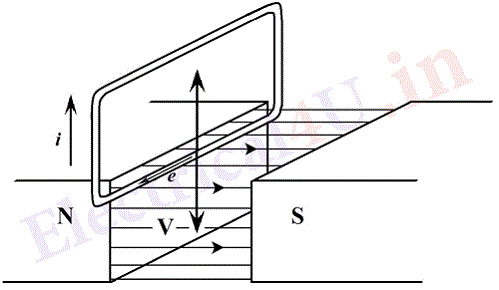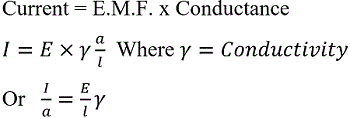The M.K.S. System of Units
An absolute system of units is one in which the units of a few fundamental quantities are selected, and those of all other quantities derived units are expressed in terms of the fundamental units in accordance with the equations expressing the physical relation existing between them.
All quantities used in mechanical science can be expressed in terms of the fundamental concepts of Length, Mass and Time, the relations being indicated by dimensional expressions, e.g.

For scientific purposes the most generally used system has been the C.G.S. system in which the fundamental units are the centimeter, the gram, and the second.
In the case of electrical or magnetic phenomena a fourth concept is required. This is of a purely electrical nature, and usually involves a property-either the permeability or the permittivity of the medium in which the phenomena occur. In the C.G.S. system these two properties, in the case of free space, were both arbitrarily assigned the value unity: but since the relation between them is such that they cannot both have the same value, this assumption gave rise to two systems of units the electromagnetic C.G.S. system and the electrostatic C.G.S. system. Of these the electromagnetic system was found to be the more generally useful, but since the size of the units was thought to be inconvenient, multiples or sub-multiples were used as Practical Units, e.g. 1 ampere = 10-1 e.m. C.G.S. units, 1 volt =108 e.m. C.G.S. units. (In contrast, I coulomb = 3 ×109 e.s. C.G.S. units and 1 Volt = 1/300 e.s. C.G.S. units.)
In 1904 it was pointed out by Professor Giorgi in Italy, and almost simultaneously and quite independently by Professor David Robertson in England, that if the fundamental units were taken as the meter, the kilogram and the second, and the permeability of free space was assigned a value of 10-7, the system of units resulting the Meter-Kilograms-Second or M.K.S. system-would include all the Practical Units, i.e. these would then become absolute units in their own right instead of being multiples or sub-multiples of the C.G.S. units.
Further, if the permittivity of free space were then given its correct value relative to that of the permeability, the electromagnetic and electrostatic systems would be included in one comprehensive system.
This suggestion lay almost dormant for many years, but in 1935 the M.K.S. system was adopted unanimously by the International Electrotechnical Commission. This at first had little effect, one reason being that no decision had been reached on the important question of rationalization. Progress in general was retarded, although in particular fields it was accelerated, by the war. However, the Rationalized M.K.S. system was adopted by the International Electrotechnical Commission in 1950 and officially recognized by the Institution of Electrical Engineers in 1952; and both the Institution and the University of London, together with other examining bodies, have signified that they intend gradually to introduce M.K.S. units into their examination papers.
Mechanical M.K.S. Units
The adoption of this system involves a new unit of Force-that force which gives unit acceleration (1 meter per second per second) to unit mass (1 kilogram)—which is called the Newton.
Clearly 1 newton = 103 x 102 = 105 dynes = 0.225 lb.
The unit of Work (or Energy) is the work done by unit force (1 newton) acting through unit distance (1 meter).
1 newton-meter = 105 X 102 dyne-cm = 107 ergs = 1 joule.
It follows that the unit of power is the joule per second or Watt.
Hence the units of energy and power are the same for both mechanical and electrical science.
Electrical M.K.S. Units
The fourth fundamental quantity need not necessarily be the permeability or permittivity of free space as long as it is electrical in nature. It is equally possible to take Current as fundamental and from the fundamental units of Length, Mass, Time, and current derive the value of the permeability. Since the concept of current is more easily grasped at an early stage than that of permeability, it is proposed in what follows to take Current as fundamental, although in what may be called the official statement of the system permeability is taken as the fourth concept.
Current (I)
Unit current the Ampere-is defined as that current which, flowing in two infinitely long conductors with their centers unit distance (1 meter) apart, in free space, produces a force between them of 2 x 10-7 newton per meter.
This definition is chiefly in the nature of a concept, although it is more capable of practical fulfilment than that of the C.G.S. unit of current.
Quantity (Q). (Q = IT.)
Unit quantity of electricity-the Coulomb is that quantity which is circulated by unit current (1 ampere) in unit time (1 second).
Hence, 1 coulomb = 1 ampere-second.
Electromotive Force (E). (W = EQ.)
The presence of an E.M.F. in any part of a circuit indicates that, in that portion, energy will be either received or given out (back-E.M.F.) when a current flows.
Unit E.M.F. the Volt exists at a point where each unit quantity (1 coulomb) receives or gives out unit energy (1 joule).
Hence,
1 volt = 1 joule per coulomb.
1 joule = 1 volt-coulomb.
Difference of Potential (V). (W =VQ.)
Unit P.D. the Volt exists between two points in a circuit, if, when a current flows, each coulomb in passing from the point of higher to the point of lower potential, gives up one joule of energy.
Resistance (R). (E/I = R or V/I = R.)
Unit resistance the Ohm is that of a circuit in which unit E.M.F. (1 volt) produces unit current (1 ampere); or that of a portion of a circuit between the ends of which unit P.D. is required to maintain unit current.
Power (P = W/T = EQ/T = EI or = VQ/T = VI).
Unit power the Watt-is that of a circuit in which unit energy is expended in unit time, i.e. 1 watt = 1 joule per second.
Magnetic M.K.S. Units Magnetic Flux

Experiment shows that the E.M.F. induced in a circuit by a change in flux is proportional to the rate of change of the flux and to the number of turns with which it is linked. Hence unit rate of change of flux is that which induces unit E.M.F. in a circuit of one turn.
The M.K.S. unit of flux is the Weber. It is defined as that flux which when withdrawn uniformly in one second from a circuit of one turn, induces in it an E.M.F. of one volt.
Hence,
1 volt = 1 weber per second
or 1 weber = 1 volt-second = 108 C.G.S. lines.

Since the M.K.S. unit of length is the meter the unit of flux density is the Weber per square meter.
Although the M.K.S. unit of flux does not, in itself, involve the idea of lines of magnetic flux, the concept is still necessary, at least in a qualitative sense, in order to visualize the field.
Hence,

E.M.F. generated in conductor moving through a Magnetic Field.
The change in the flux linking a circuit may be produced either by a change in the value of the flux itself or by relative motion between the circuit and the flux. In the latter case, since the lines of magnetic flux are assumed to form closed loops, it is usually more convenient to consider that the E.M.F. is due to the flux cutting the circuit or vice versa.
Consider a conductor, of effective length l meters, lying in a field of uniform density B webers per square meter and forming the lower side of a single turn (figure) which is moving downwards in a direction perpendicular to the field with a constant velocity of V meters per second. [If the conductor is not perpendicular to the field the effective length is its perpendicular component.]
The flux passing through the turn is increasing at a rate
BlV webers per second.
Hence, the generated E.M.F. is

If either flux density or velocity (or both) are not uniform, the generated E.M.F. at any instant is

Where B and v are corresponding instantaneous values.
In electrical machines v is usually constant so that e ∝ B.

Force acting on a Current-carrying Conductor lying in a Magnetic Field
Experiment shows that a conductor carrying a current and lying in a magnetic field experiences a force in a direction perpendicular to that of both current and field, which is proportional to the effective length of the conductor, the current, and the strength of the field.
Referring again to figure, suppose that the E.M.F. e volts generated in the moving conductor, causes a current i amperes. This represents a power of ei watts, and in a time dt.
Electrical output = ei dt joules.The only source of this energy is the work done in moving the conductor through a distance da against the force F acting on it.
Mechanical work done = F dx joules, where F is the force in newton.
Therefore,

The Magnetic Circuit
All lines of magnetic flux are closed loops, and the general path taken by the flux is termed the magnetic circuit. In most cases because of leakage it cannot be defined as precisely as the electric circuit, and in some ways the two are fundamentally different. Nevertheless there is some similarity between the two groups of fundamental concepts, and the relationships between them are similar in form, so that it is often helpful to illustrate the one in terms of the other. In the electric circuit,

Where Resistance depends upon the dimensions of the circuit and on the material.
This can be written,

Or
i.e. Current density = E.M.F per unit length × Conductivity.h.
In the magnetic circuit,

Where Reluctance depends on the dimensions of the circuit and on the material.
This can be written,
Flux = M.M.F × Permeance.

Where, µ = Permeability
i.e. Flux density = M.M.F per unit length × permeability.
The M.M.F per unit length is called the Magnetizing Force (H) so that,
Flux Density = Magnetizing Force × Permeability

The Permeability of Free Space
Since Magnetizing Force is Magneto-motive Force per unit length, it follows that in the neighborhood of a long straight conductor,

Where r is in cm.
But in (un-rationalized) M.K.S. units, since the ampere is an absolute unit,

Where r is in m., and the corresponding flux density is


If a second conductor carrying an equal current I is placed parallel to the first and distant r meters from it (fig.2 ), the force set up between them is

And if r = l =1 m. and I =1 ampere,
F = 2μ Newtons per meter.
But, by definition, under these conditions the force is 2 × 10-7 Newton, so that
2 × 10-7 = 2μ or μ = 10-7 … (7)
i.e. in the (un-rationalized) M.K.S. system the permeability of free space (or air, very nearly) is 10-7
